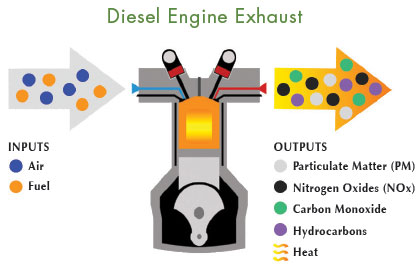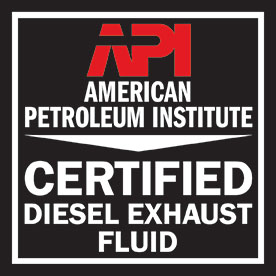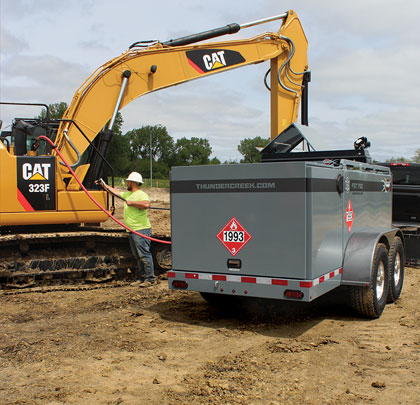Over the past few years, refilling with Diesel Exhaust Fluid (DEF) has become a part of regular maintenance on equipment that is 75 hp and above. Depending on what machines you run, you may need to refill DEF as frequently as every time you fuel. The challenge is that DEF is different than most fluids we’re used to handling. Here’s what you need to know.
HOW DEF CAME TO BE
All diesel engines produce the same five emissions: Particulate Matter (PM), Nitrogen Oxides (NOx), Carbon Monoxide, Hydrocarbons, and heat. Since 1996, when the EPA introduced the Tier Emissions Standards, the focus has been on reducing PM and NOx.
PM is created when fuel is not completely burned and is composed of small carbon particles and other substances. When nitrogen and oxygen combine at high temperatures they react; the resulting output is what’s known as NOx.
Inside the combustion chamber of a diesel engine, PM and NOx have conflicting chemical factors. When the engine is operating most efficiently for power, minimal PM is produced but NOx levels are very high. When exhaust gas is recirculated back into the intake, NOx production is reduced; however, higher levels of PM are created. Because of this, no diesel engine can be designed to meet both PM and NOx emission standards without the use of an exhaust treatment system.
Today, all manufacturers of diesel engines larger than 75 hp are using a process called Selective Catalytic Reduction (SCR). SCR injects DEF into the exhaust stream to control and break down the NOx pollutants. DEF and NOx react and convert to water vapor and nitrogen, which are then released from the equipment’s tailpipe.

THE BASICS OF DEF
DEF is 32.5 percent automotive grade urea and 67.5 percent deionized water. It’s a stable, colorless liquid that is non-toxic, non-polluting, non-flammable, and non-hazardous. It is corrosive to most metals and coatings; however, if a small amount is spilled it can simply be rinsed and wiped up with water.
Temperature: Temperature affects DEF as it relates to shelf life. Prolonged exposure to direct sunlight and high temperatures will cause DEF to degrade quicker. Stored under average temperatures of 50°F, DEF is good for 36 months. This reduces to 18 months at 77°F, 12 months at 86°F, and just 6 months for DEF that is consistently exposed to temperatures above 96°F. DEF freezes at 12°F.
Contamination: The biggest concern with using DEF in off-road environments is that it is easily contaminated. Direct or airborne contact with as little as 1/10 of a teaspoon of many common elements is enough to bring an entire 5,000 gallon tanker of DEF off-spec according to the ISO 22241 Standard, which outlines the practices for manufacturing and handling the fluid. Using contaminated DEF can be costly for your operation, both financially and in terms of productivity.

PURCHASING DEF
DEF is most commonly sold in jugs, 55-gallon drums, 275- or 330-gallon IBC totes, and in bulk. Look for the API Certified Diesel Exhaust Fluid logo on product packaging to ensure the fluid was manufactured in accordance with the ISO standard to maintain purity.
STORING AND HANDLING DEF
The greatest threat to DEF purity comes from the containers and pumping systems used to store and transport the fluid. The ISO standard recommends avoiding the following materials:
- Materials forming compounds as a result of reactions with ammonia, which may negatively interfere with the SCR converter system: carbon steels, zinc coated carbon steels, mild iron
- Non-ferrous metals and alloys, including copper, copper alloys, zinc, lead
- Aluminum and aluminum alloys
- Plastics or metals coated with nickel
Contact with trace elements of any of the following materials will contaminate DEF: copper, zinc, chromium, nickel, iron, aluminum, phosphorous, magnesium, calcium, sodium, and potassium.
DEF should be handled in dedicated containers that were manufactured specifically for use with DEF. They should be made with materials approved in the ISO standard and rinsed and sealed accordingly. Do not reuse or refill open containers and avoid incorrect dispensing materials, such as metal funnels, steel transfer containers, incorrect pumps, seals, and fittings.
Ideally, DEF should remain in a closed loop from the supply all the way to machinery in the field. While the standard does allow for open systems, they must be rinsed and flushed between each use. Since this isn’t practical in off-road environments, closed-loop systems provide the most protection from contamination.
PURCHASING DEF HANDLING EQUIPMENT
Here are some things to keep in mind when purchasing DEF handling equipment:
- Is the tank and pumping system made in compliance with the ISO 22241 Standard?
- Is it a closed-loop system?
- Will the capacity meet my fluid needs?
- Will a stationary or mobile solution work best for my operation?
- Do I need a heating solution?
Thunder Creek Equipment has pioneered industry-leading systems for handling DEF in off-road environments, including DEF totes designed to fit in a truck bed and DEF systems incorporated into their newly redesigned fuel and service trailers. Made in strict accordance to the ISO standard and equipped with the exclusive, closed-loop 2-in-1 DEF Pumping System (patent-pending), the systems remain ISO compliant for life.
DEF IS HERE
Using DEF in your operation is inevitable. If your equipment doesn’t currently require it, it will in the coming years.
While there has been a fair amount of publicity surrounding the negative aspects of the fluid, there are positives as well. For your operation, SCR technology has led to an increase in fuel economy. For all of us, it has drastically reduced emissions that cause pollution.
The reality is when DEF is handled properly there is little risk to your operation and machinery. As the old saying goes, “an ounce of prevention is worth a pound of cure.” Share this article with your team. Proper education will protect your machinery and keep your operation on the move. ■
About The Author: Luke Van Wyk is general manager of Thunder Creek Equipment. For more information about handling DEF, visit www.thundercreek.com. Article sources: ISO 22241 Standard, Thunder Creek Equipment, DiscoverDEF.com, and Brenntag.
_________________________________________________________________________
Modern Contractor Solutions, June 2015
Did you enjoy this article?
Subscribe to the FREE Digital Edition of Modern Contractor Solutions magazine.



